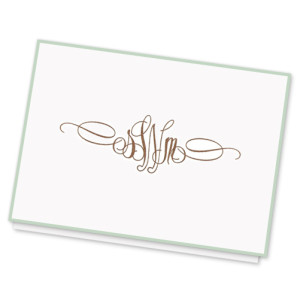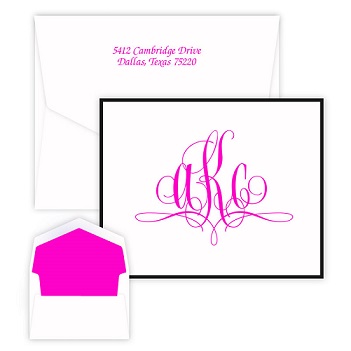Monogram Magic: What is a Monogram?
 In two previous blogs, we talked about the ancient history of monograms that traces all the way back to the Greeks, as well as the Victorian mania for monograms that had people putting their monograms on everything from their tablecloths to their bloomers. Today, we’ll be taking a step back and asking: what is a monogram? Be prepared to learn some things to pull out at your next cocktail party conversation.
In two previous blogs, we talked about the ancient history of monograms that traces all the way back to the Greeks, as well as the Victorian mania for monograms that had people putting their monograms on everything from their tablecloths to their bloomers. Today, we’ll be taking a step back and asking: what is a monogram? Be prepared to learn some things to pull out at your next cocktail party conversation.
If you ask your friends what a monogram is, they might say that it’s a series of three letters representing your name.
That’s all well and good, but, actually, the common dictionary definition of a monogram does not include a specific number of letters. Merriam-Webster Dictionary says a monogram is “a sign of identity usually formed of the combined initials of a name.”
The word “monogram” derives from two Greek words: mono, meaning single, and gram, meaning letter. It means that letters were combined into one sign or symbol.
So in contemporary, popular culture, the idea of a monogram is actually not well-defined. Can it have two letters? Five letters? Do the letters connect or can they float freely? How are they arranged: sideways or up-and-down? Are letters block or script? In today’s world, we don’t seem to sweat the details; all seem acceptable.
In the Victorian Age (1837-1901), people thought that sometimes the letters of a monogram should connect and intertwine, even if that meant you couldn’t actually read the letters. At other times, legibility was important.

The Sienna Monogram Note features a flowing, elegant monogram where letters overlap and interlace, and are almost difficult to read.
Here’s J.O. Kane, the editor of An Encyclopedia of Monograms, writing in 1884: “For some uses, the intention of the device should be conspicuous and obvious, and its component letters readily distinguishable at first sight. In other cases, it is more tasteful and appropriate, by superimposing or interlacing the letters, or other means, to slightly veil, as it were, the meaning of the composition, and to aim at a certain ornamental construction whose component parts shall be less distinct and obvious to the eye.”
Cipher Vs. Monogram?
If you are the type of person who likes rules, a modern monogram scholar, Nancy Sharon Collins, author of The Complete Engraver, introduces the term “cipher” to help to clarify the situation – perhaps.
“A cipher,” she writes, “is any arrangement of two or more initials. The letters do not have to connect.”
“The letters of a monogram on the other hand,” writes Collins, “share essential strokes and curves. Monograms do not have to be legible, whereas ciphers typically are.”
Let’s note that we usually associate the word “cipher” with the idea of a code or something you have to interpret. For this reason, we aren’t sure that the term cipher helps clear things up. The meaning fights its colloquial use and may muddy the waters more: Ciphers – free-standing letters – are actually easier to read than monograms – highly interconnected letters that can be hard to read.
Types of Monograms
If we look at the designs offered here at giftsin24.com, we see a variety of styles, both “ciphers” and “monograms.” We label all these marks “monograms” on our website.
We have block letters that don’t touch. These, Collins would say, are ciphers.
We have two-letter monograms, such as Dorset. The strokes overlap. It’s hard to tell one letter from another. For these reasons, Dorset might fall into the category of a true monogram, even though it’s only two letters.

Dorset two-letter monogram includes letters that overlap and are more difficult to read. Here is a T and an H.
And, giftsin24 also features three-letter monograms where letters thread through one another.
So there, you have it…some food for thought about the exciting world of monograms. Are you ready for your next cocktail party? Tune in next time when we explore the modern uses and meanings of monograms.
Sources:
Nancy Sharon Collins. The Complete Engraver: Monograms, Crests, Ciphers, Seals, and the Etiquette of Social Stationery. Princeton Architectural Press, 2012.
J. O’Kane. An Encyclopedia of Monograms. Originally published in 1884. Reprinted by Dover Publishing in 2003.







Leave a comment